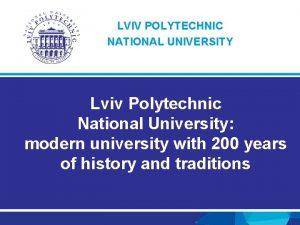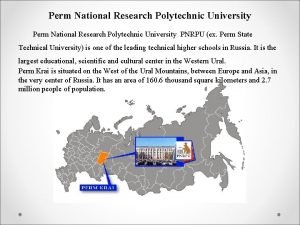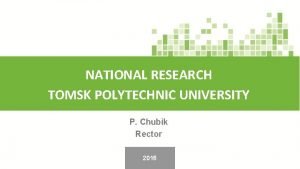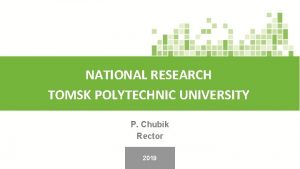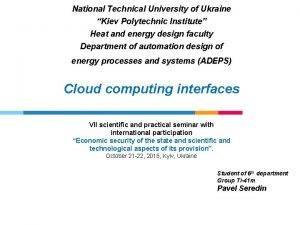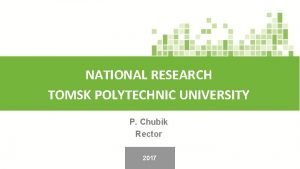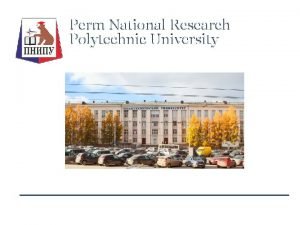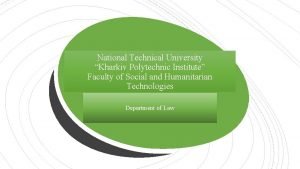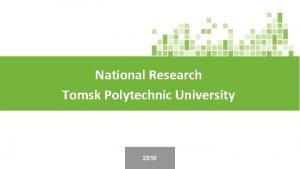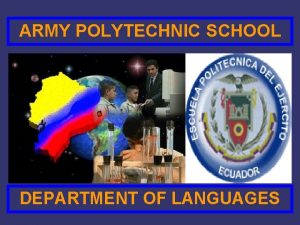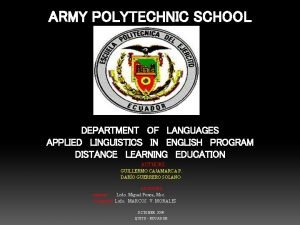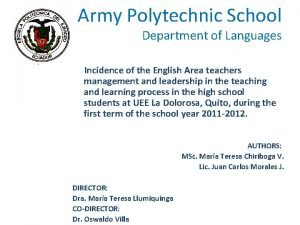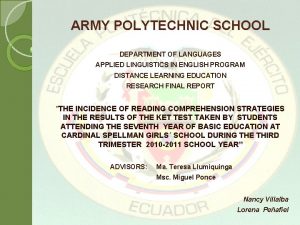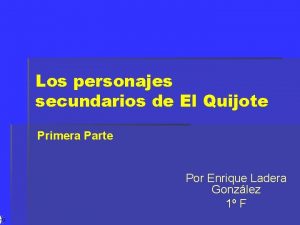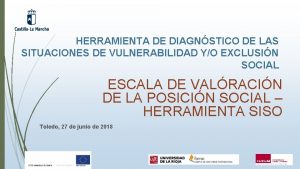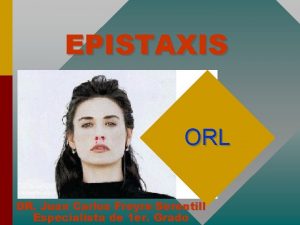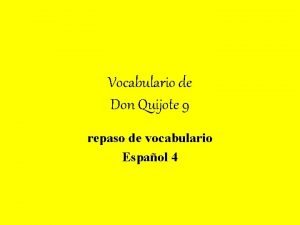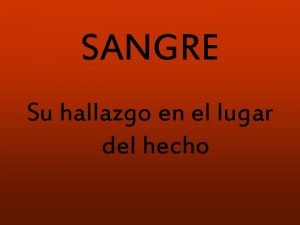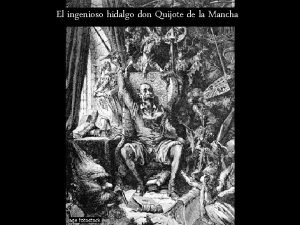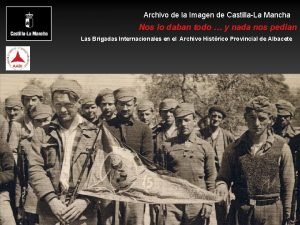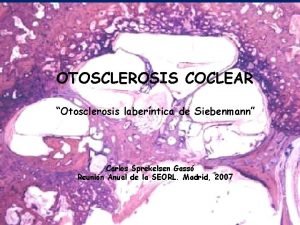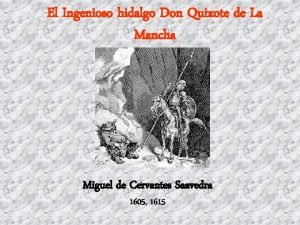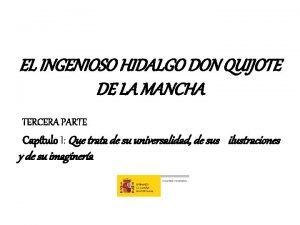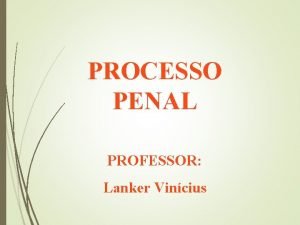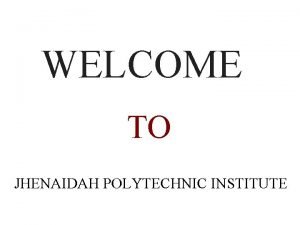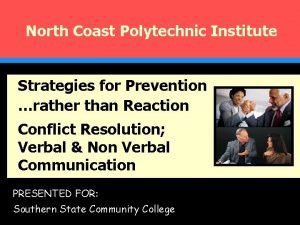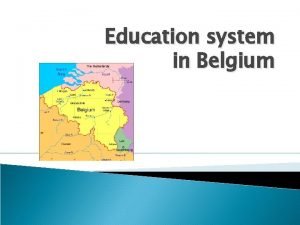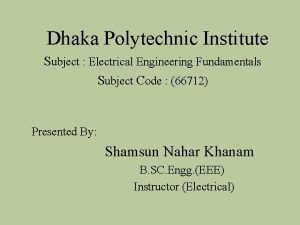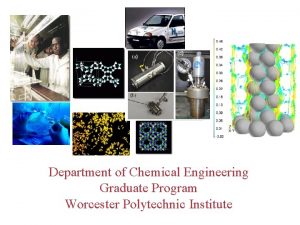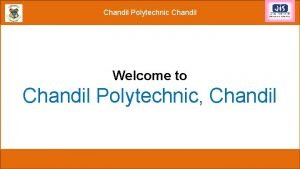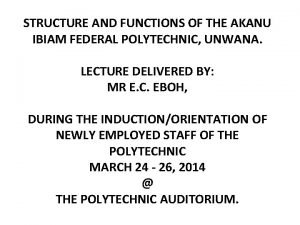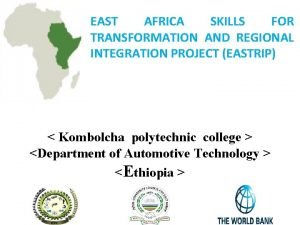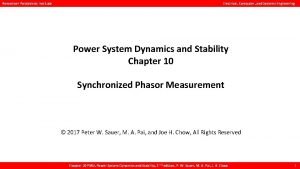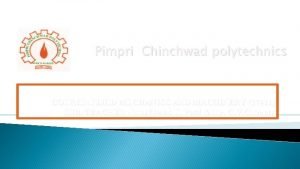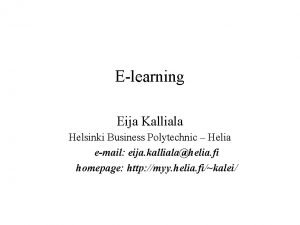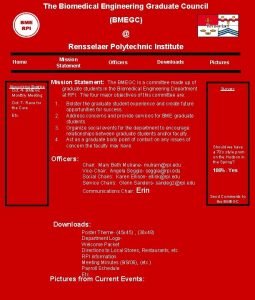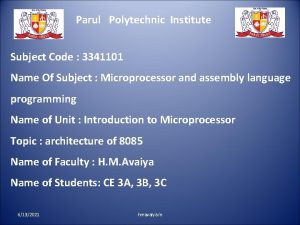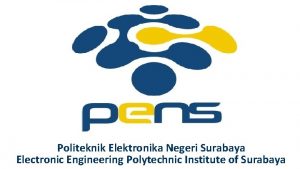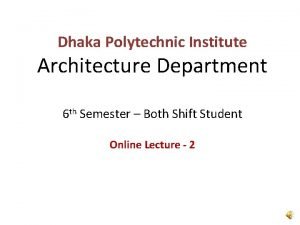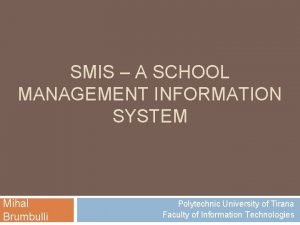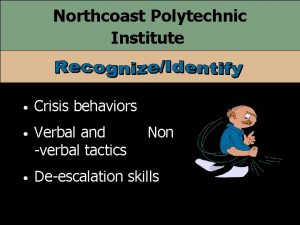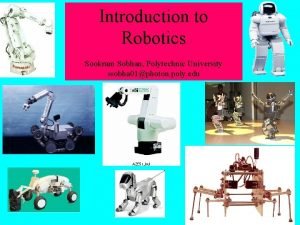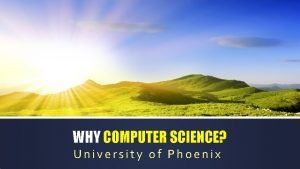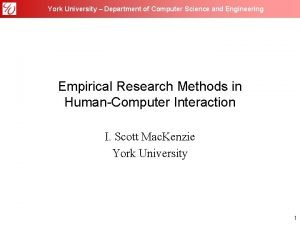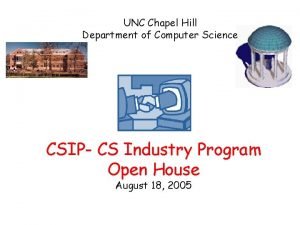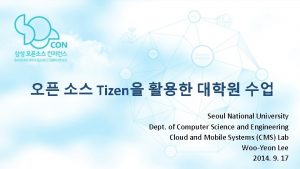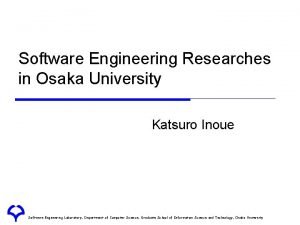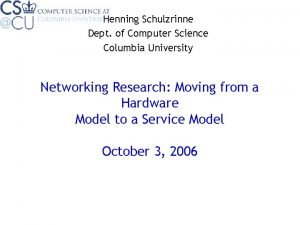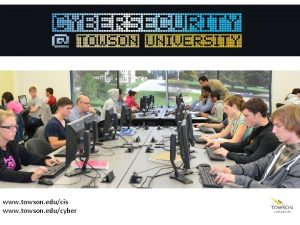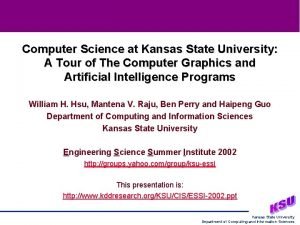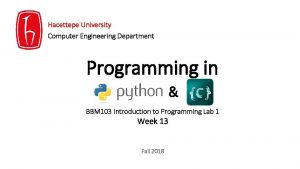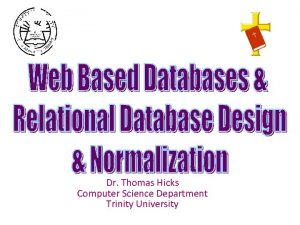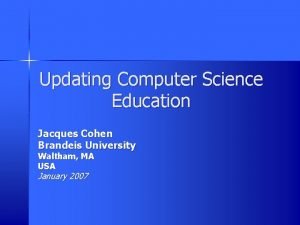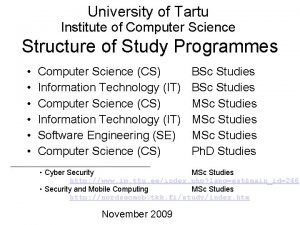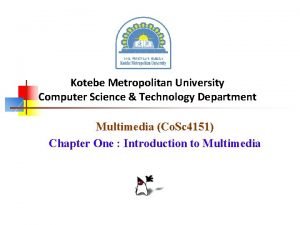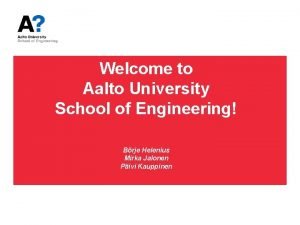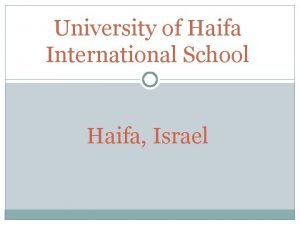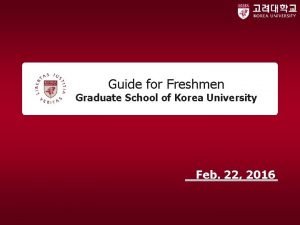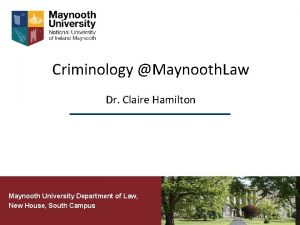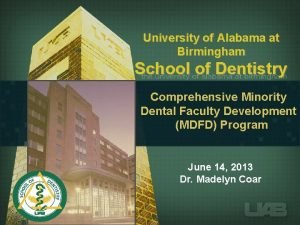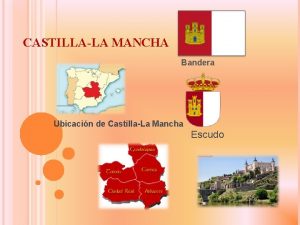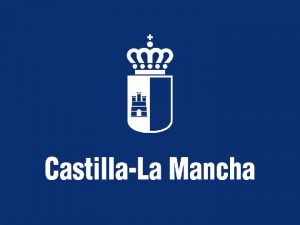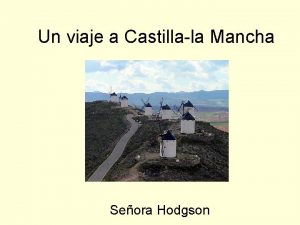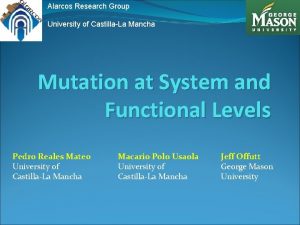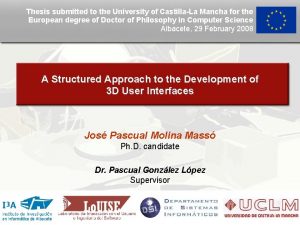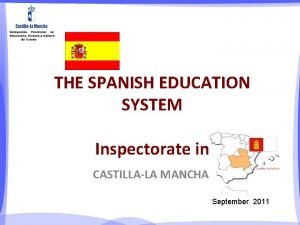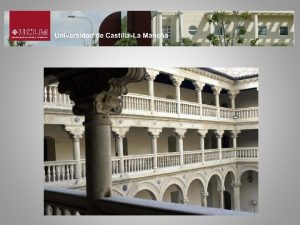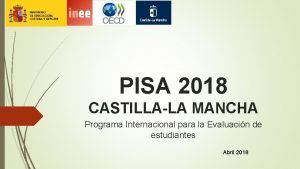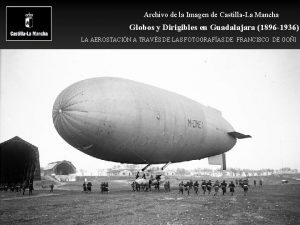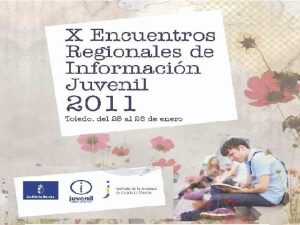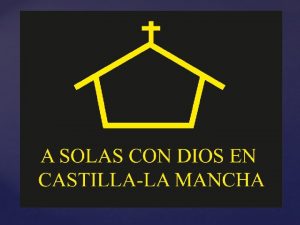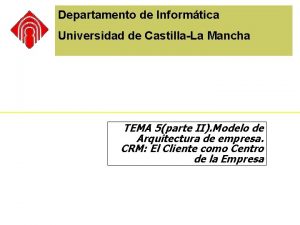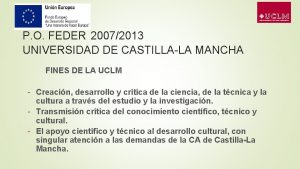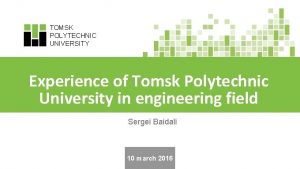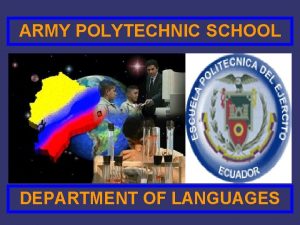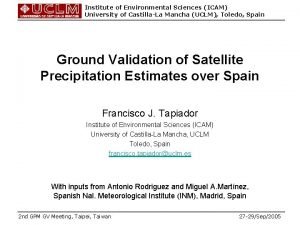UNIVERSITY OF CASTILLALA MANCHA SUPERIOR POLYTECHNIC SCHOOL Computer





















































































- Slides: 85

UNIVERSITY OF CASTILLA-LA MANCHA SUPERIOR POLYTECHNIC SCHOOL Computer Systems Department Task-Oriented and User-Centred Process Model for Developing Interfaces for Human-Computer-Human Environments Author: Victor M. R. Penichet November, 2007 Supervisors: Dra. Maria D. Lozano Dr. Jose A. Gallud

Task-Oriented and User-Centred Process Model for Developing Interfaces for Human-Computer-Human Environments Index n n n Introduction CSCW Origin and State of the Art Basic Concepts regarding CSCW Environments Conceptual Model for CSCW Environments TOUCHE Task-Oriented and User-Centred Process Model for Developing Interfaces for Human-Computer-Human Environments n n n Case Study TOUCHE CASE Tool Conclusions, Contributions and Future Works University of Castilla-La Mancha PH. D. Thesis Albacete, 2007

Task-Oriented and User-Centred Process Model for Developing Interfaces for Human-Computer-Human Environments Index n Introduction Motivation ¨ Objectives ¨ n n n n CSCW Origin and State of the Art Basic Concepts regarding CSCW Environments Conceptual Model for CSCW Environments TOUCHE Case Study TOUCHE CASE Tool Conclusions, Contributions and Future Works University of Castilla-La Mancha PH. D. Thesis Albacete, 2007

Task-Oriented and User-Centred Process Model for Developing Interfaces for Human-Computer-Human Environments Introduction Motivation n At the beginning, technology solved problems that people had in an individual way. Soon afterwards, groups of people work together through computer networks. Technology has evolved to cover people’s needs: communication and collaboration among them to achieve a common objective. Computer Science systems have evolved in such a manner that now we usually talk about software communities instead of Personal Computers. University of Castilla-La Mancha PH. D. Thesis Albacete, 2007

Task-Oriented and User-Centred Process Model for Developing Interfaces for Human-Computer-Human Environments Introduction Motivation CSCW: Groupware: Computer-Supported Applications SE: Software Cooperative based Engineering on CSCW Work n n CSCW allows extending ideas from different fields to computation. SE has guided the development of software applications ¨ n n process models and methodologies. SE could guide the development of groupware applications. But… groupware has special characteristics: collaboration, cooperation, communication, coordination, time, space, etc. ¨ if considered, they can contribute to achieve a quality development ¨ Q University of Castilla-La Mancha PH. D. Thesis Albacete, 2007

Task-Oriented and User-Centred Process Model for Developing Interfaces for Human-Computer-Human Environments Introduction Main Objective n The definition of a process model and a methodology development of CSCW interfaces ¨ attending explicitly to the specific features ¨ to cover the lack of specific methods in this sense ¨ 1 2 3 4 Requirements gathering Analysis Client Prototype and User evaluation Design Implementation University of Castilla-La Mancha PH. D. Thesis Albacete, 2007

Task-Oriented and User-Centred Process Model for Developing Interfaces for Human-Computer-Human Environments Introduction Objectives n Knowing time-space, collaboration, cooperation, coordination, communication concepts. Analysing the way in which task modelling, awareness and the Model-Based User Interface Development approach can be adapted and extended to be applied for Collaborative Environments. n Conceptual model ¨ n Process model ¨ n Intra & inter-stage Case study ¨ n to be used in every stage in the defined process model Traceability ¨ n to develop quality CSCW systems which considers the user as part of a group and taken into account special features on the user interface. Methodology ¨ n common and well defined vocabulary to validate its utility and to show an example of use. Tool CASE prototype ¨ to support and automate the proposed process model. University of Castilla-La Mancha PH. D. Thesis Albacete, 2007

Task-Oriented and User-Centred Process Model for Developing Interfaces for Human-Computer-Human Environments Index n n Introduction CSCW Origin and State of the Art CSCW & Groupware ¨ Classifications ¨ Advantages and Disadvantages ¨ Some Examples ¨ n n n Basic Concepts regarding CSCW Environments Conceptual Model for CSCW Environments TOUCHE Case Study TOUCHE CASE Tool Conclusions, Contributions and Future Works University of Castilla-La Mancha PH. D. Thesis Albacete, 2007

Task-Oriented and User-Centred Process Model for Developing Interfaces for Human-Computer-Human Environments CSCW Origin and State of the Art The very beginning of CSCW and groupware n Mid ’ 70 s Office Automation ¨ n n n Extension of some applications to group ideas 1981 Groupware ¨ Peter y Trudy Johnson-Lenz, 1978: “intentional group processes plus software to support them” Mid ’ 80 s CSCW ¨ From a multidisciplinary conference ¨ S. Greenberg, 1991: ”The study and theory of how people work together, and how the computer and related technologies affect group behavior. ” CSCW starts as an effort from very different fields with an only objective: people interested in using technology to support them in their work University of Castilla-La Mancha PH. D. Thesis Albacete, 2007

Task-Oriented and User-Centred Process Model for Developing Interfaces for Human-Computer-Human Environments CSCW Origin and State of the Art The basis of CSCW Coordination n Cooperation & Colaboration Communication Groupware is application & CSCW is the philosophy behind groupware University of Castilla-La Mancha PH. D. Thesis Albacete, 2007

Task-Oriented and User-Centred Process Model for Developing Interfaces for Human-Computer-Human Environments CSCW Origin and State of the Art Classifications n Classifications are a way to order groupware applications to know their features n First classification: Johansen’s Time-Space Matrix n Different Time Same place Face to face interaction Asynchronous interaction Different place Synchronous distributed interaction Asynchronous distributed interaction But applications are getting more and more complicated ¨ n Same Time Sometimes it is very difficult to classify an application into one only cell There are some other newer solutions: Grudin, Ellis, Andriessen, De. Sanctis, etc. University of Castilla-La Mancha PH. D. Thesis Albacete, 2007

Task-Oriented and User-Centred Process Model for Developing Interfaces for Human-Computer-Human Environments CSCW Origin and State of the Art Classifications Our proposal Regarding Time/Space Information Communica Sharing No=0, Yes=1 Space Type Coordina No=0, Yes=1 Shyncr No=0, Yes=1 Ashyncr No=0, Yes=1 Same No=0, Yes=1 Different No=0, Yes=1 0 0 0 1 CSCW Features Type Time X 0 0 0 2 0 0 1 0 A 0 0 1 3 0 0 1 1 B 0 1 0 4 0 1 0 0 C 0 1 1 5 0 1 D 1 0 0 6 0 1 1 0 E 1 0 1 7 0 1 1 1 8 1 0 0 0 F 1 1 0 9 1 0 0 1 G 1 10 1 0 11 1 0 1 1 12 1 1 0 0 13 1 1 0 1 14 1 1 1 0 PH. D. Thesis 1 1 Albacete, 20071 1 Regarding CSCW features University of Castilla-La Mancha 15

Task-Oriented and User-Centred Process Model for Developing Interfaces for Human-Computer-Human Environments CSCW Origin and State of the Art Classifications CSCW Features Type Application Time / Space Collabora Communi Coordina N=0, S=1 Shyncr No=0, Yes=1 Ashyncr No=0, Yes=1 Same No=0, Yes=1 Different No=0, Yes=1 C-7 Event management 0 1 1 1 C-7 Agenda 0 1 1 1 D-11 Co-navigator 1 0 0 1 1 D-11 Shared whiteboard 1 0 0 1 1 1 F-13 Presentation systems 1 1 0 1 G-11 GDSS 1 1 0 1 1 G-15 BSCW 1 1 1 1 1 0 0 1 1 1 0 1 0 1 0 0 1 B-7 F-7 Notification systems Sharepoint F-10 Meeting Room F-9 B-5 Video-conference E-mail 0 1 0 1 G-7 Original and basic definition University of Castilla-La Mancha E-mail 1 1 1 Additional functionality PH. D. Thesis Albacete, 2007 0 1 1 1

Task-Oriented and User-Centred Process Model for Developing Interfaces for Human-Computer-Human Environments CSCW Origin and State of the Art Some examples large displays architectures Communities Interactions with shared displays Operational transformation Knowledge sharing Tabletop design Gesturing, moving and talking together Organizational issues Interruptions University of Castilla-La Mancha Evaluation methods Bridging the physical and the digital PH. D. Thesis Medical applications Distilling knowledge Systems Games Information sharing and access Social awareness and availability Cases from the field Understanding CSCW: looking from above Albacete, 2007 Distributed teams Synchronous collaboration

Task-Oriented and User-Centred Process Model for Developing Interfaces for Human-Computer-Human Environments Index n n n Introduction CSCW Origin and State of the Art Basic Concepts regarding CSCW Environments Concepts ¨ CSCW Methodologies ¨ The need of a common language ¨ n n n Conceptual Model for CSCW Environments TOUCHE Case Study TOUCHE CASE Tool Conclusions, Contributions and Future Works University of Castilla-La Mancha PH. D. Thesis Albacete, 2007

Task-Oriented and User-Centred Process Model for Developing Interfaces for Human-Computer-Human Environments Basic Concepts regarding CSCW Environments Since every researcher, in every CSCW research, considers some concepts… …when talking about CSCW it is necessary to know about… University of Castilla-La Mancha PH. D. Thesis Albacete, 2007

Task-Oriented and User-Centred Process Model for Developing Interfaces for Human-Computer-Human Environments Basic Concepts regarding CSCW Environments n Organizational structure, group, role, actor ¨ On modelling techniques n ¨ Agents n ¨ n Odell, 2005; Mellouli, 2002; Van Dyke Parunak, 2001; Methodological environments n ¨ Traetteberg, 1999; Paternò, 1999; Pinelle, 2003; Van der Veer, 2000; AMENITIES [Garrido, 2003] or CIAM [Molina, 2006] Wf. MC Communication, cooperation, colaboration, coordination, information sharing Grudin, 1994; Poltrock, 1994; Target, 1997; etc. ¨ Wf. MC, Wil van der Aalst (2004), etc. : coordination Workflow ¨ The basis of CSCW ¨ n Space, time, shyncronous, ashyncronous, same space, different space ¨ Johansen, 1988; Ellis, 1991; Wf. MC (Parallel, sequential, deadline…) University of Castilla-La Mancha PH. D. Thesis Albacete, 2007

Task-Oriented and User-Centred Process Model for Developing Interfaces for Human-Computer-Human Environments Basic Concepts regarding CSCW Environments Tasks and group tasks n Task A very wide discussed concept: HCI, MB-UIDE, workflow, etc. ¨ Task analysis ¨ n n n ¨ HTA (Hierarchical Task Analysis) [Annett, 1967] GOMS (Goals, Operators, Methods, Selection rules) [Card, 1983] UAN (User Action Notation) [England, 1998] Collaboration Usability Analisys (CUA) [Pinelle, 2003] Groupware Task Analysis (GTA): Designing for Users and Tasks from Concepts to Handles (DUTCH) [Van der Veer, 2000] Wf. MC (process) University of Castilla-La Mancha PH. D. Thesis Albacete, 2007

Task-Oriented and User-Centred Process Model for Developing Interfaces for Human-Computer-Human Environments Basic Concepts regarding CSCW Environments Tasks and group tasks the notation we use… ¨ Concur. Task. Trees (CTT) [Paternò, 1999] n n n A notation for task model specifications to design interactive applications Hierarchical structure Graphical syntax Concurrent notation, operators Focus on activities Tasks are described by means of ¨ Name, type, subtask of, objetcs, iterative, first action, last action n Several operators n Different types of tasks University of Castilla-La Mancha PH. D. Thesis Albacete, 2007

Task-Oriented and User-Centred Process Model for Developing Interfaces for Human-Computer-Human Environments Basic Concepts regarding CSCW Environments Tasks and group tasks Notation Operator T 1 ||| T 2 interleaving T 1 [] T 2 choice T 1 |[]| T 2 synchronization the two tasks have to synchronize on some actions in order to exchange information T 1 |=| T 2 order independence The two tasks must be performed. The first one must finish its performance before the second one starts T 1 [> T 2 deactivation when one action from the second task occurs the first task is deactivated T 1 >> T 2 enabling when the first task is terminated then the second task is activated T 1 []>> T 2 enabling with information passing T 1 |> T 2 Description iteration T 1(n) finite iteration [T 1] optional task T recursion Type of tasks the actions of the two tasks can be performed in any order selection between tasks In this case we want to highlight that when T 1 task terminates it provides some value for task T 2 besides activating it suspend-resume Suspension / resumpsion of the task T 1* Operators Abstraction. are tasks which require complex actions. Interaction: are performed by user interactions with the system. Application: are completely executed by the system. the task is iterative how many times the task will be performed is specified its performance is not mandatory User: are performed by the user, without interacting with the system the possibility to include in the task specification the task itself. Cooperation: composite tasks where several users participate University of Castilla-La Mancha PH. D. Thesis Albacete, 2007

Task-Oriented and User-Centred Process Model for Developing Interfaces for Human-Computer-Human Environments Basic Concepts regarding CSCW Environments Tasks and group tasks University of Castilla-La Mancha PH. D. Thesis Albacete, 2007

Task-Oriented and User-Centred Process Model for Developing Interfaces for Human-Computer-Human Environments Basic Concepts regarding CSCW Environments Awareness and shared workspace n Awareness: “knowing what is going on” [Endsley, 1995] n Gutwin and Greenberg [Gutwin, 2004] summarize four important points about awareness Awareness is knowledge about the state of a particular environment. ¨ Environments change over time, so awareness must be kept up to date. ¨ People maintain their awareness by interacting with the environment. ¨ Awareness is usually a secondary goal —that is, the overall goal is not simply to maintain awareness but to complete some task in the environment. ¨ n It is very related to shared context: A shared context is a set of objects where the objects and the actions performed on the objects are visible to a set of users. [Ellis, 1991] University of Castilla-La Mancha PH. D. Thesis Albacete, 2007

Task-Oriented and User-Centred Process Model for Developing Interfaces for Human-Computer-Human Environments Basic Concepts regarding CSCW Environments Awareness and shared workspace Workspace awareness elements (past) Workspace awareness elements [Gutwin, 1997] Category Element Specific questions Who Presence Identity Authorship Is anyone in the workspace? Who is participating? Who is that? Who is doing that? How Action history Artifact history How did that operation happen? How did this Artifact come to be in this state? What Action Intention Artifact What are they doing? What goal is that action part of? What object are they working on? When Event history When did that event happen? Who (past) Presence history Who was here, and when? Location Gaze View Reach Where are they working? Where are they looking? How much can they see? How far can they reach? Where (past) Location history Where has a person been? What (past) Action history What has a person been doing? Where n techniques to support workspace awareness [Gutwin, 2004] ¨ embodiments n ¨ expressive artifacts n ¨ can provide people with a representation in the workspace objects that maximize the amount of feedthrough information that is provided for the group’s benefit. visibility techniques n address the visibility problem University of Castilla-La Mancha PH. D. Thesis Albacete, 2007

Task-Oriented and User-Centred Process Model for Developing Interfaces for Human-Computer-Human Environments Basic Concepts regarding CSCW Environments Model-Based User Interface Design n Most of them considers concepts such as ¨ n CIO (Concrete Interaction Objetct), AIO (Abstract Interaction Objetct), PU (Presentation Unit) Some approaches: ¨ ¨ ¨ ¨ ¨ TRIDENT (Tools fo. R an Interactive Development ENvironmen. T) [Bodart, 1990] UIDE (User Interface Design Environment) [Foley, 1991] JANUS [Balzert, 1996] MASTERMIND [Szekely, 1996] MOBI-D (Model-Based Interface Designer) [Puerta, 1996] [Puerta, 1997] OVID (Object, View and Interaction Design) [Roberts, 1998] TADEUS [Stary, 1999; Stoiber, 2000] Wisdom (Whitewater Interactive System Development with Object Models) [Nunes, 2001] IDEAS (Interface Development Environment within OASIS) [Lozano, 2001] UMLi (The Unified Modeling Language for Interactive Applications) [Silva, 2000] [Silva, 2002] Just-UI [Molina, 2003] OO-H (Object Oriented Hypermedia Method) [Cachero, 2003] TERESA (Transformation Environment for inte. Ractiv. E Systems represent. Ations) [Mori, 2004; Paternò, 2006] Usi. XML (USer Interface e. Xtensible Markup Language) [Limbourg, 2004] AB-UIDE (Agent-Based User Interface Development Environment) [López, 2004] [López, 2005] IDEALXML [Montero, 2005] CIAM (Collaborative Interactive Applications Methodology) [Molina, 2006] Flowi. XML [Guerrero, 2007] University of Castilla-La Mancha PH. D. Thesis Albacete, 2007

Task-Oriented and User-Centred Process Model for Developing Interfaces for Human-Computer-Human Environments Basic Concepts regarding CSCW Environments Model-Based User Interface Design n TRIDENT: the very beggining [Bodart, 1990; Bodart, 1995] ¨ AIOs CIOs widgets (windows gadgets) or controls or physical interactors (according to IFIP terminology) n IDEAS [Lozano, 2001] n UMLi [Silva, 2000] Diagrama Component de Interacción Specification de. Diagram Diálogos Extends UML ¨ Grouping objects ¨ n Usi. XML [Limbourg, 2004] Facets ¨ Describing AIOs ¨ AIOs: platform and modality independence ¨ University of Castilla-La Mancha PH. D. Thesis UI Diagram Framework Cameleon Reference Albacete, 2007

Task-Oriented and User-Centred Process Model for Developing Interfaces for Human-Computer-Human Environments Basic Concepts regarding CSCW Environments Methodologies for CSCW systems n There is a lack in this sense ¨ n Many approaches ¨ ¨ n [Dumont, 2001] describes a method to specify interfaces by using scenarios [Zhao, 2001] briefly shows the process model of a cooperative design [Kirsh, 2004; Morris, 2004] talk about methodologies to evaluate Etc. AMENITIES (A MEthodology for a. Nalysis and des. Ign of coopera. TIve syst. Em. S) [Garrido, 2003] ¨ n Many methodologies and process models, but no specific ones regarding CSCW systems It does not take into account UI CIAM (Collaborative Interactive Applications Methodology) It is not a process model, but a methodology which could be integrated into a process model ¨ It has been parallel developed to TOUCHE ¨ University of Castilla-La Mancha PH. D. Thesis Albacete, 2007

Task-Oriented and User-Centred Process Model for Developing Interfaces for Human-Computer-Human Environments Index n n Introduction CSCW Origin and State of the Art Basic Concepts regarding CSCW Environments Conceptual Model for CSCW Environments An Ontology as a Solution ¨ The Conceptual Model ¨ n n TOUCHE Case Study TOUCHE CASE Tool Conclusions, Contributions and Future Works University of Castilla-La Mancha PH. D. Thesis Albacete, 2007

Task-Oriented and User-Centred Process Model for Developing Interfaces for Human-Computer-Human Environments Conceptual Model for CSCW Environments The need of a common language Psychology Philosophy CSCW … and many other areas… Computer Science Anthropology Research fields inside Computer Science University of Castilla-La Mancha PH. D. Thesis Albacete, 2007

Task-Oriented and User-Centred Process Model for Developing Interfaces for Human-Computer-Human Environments Conceptual Model for CSCW Environments The need of a common language n Getting a common well-defined vocabulary… ¨ n … is very important when people from different fields work together There are several approaches to classify and/or specify concepts related to a specific domain: ¨ Taxonomies n ¨ Folksonomies (Vander Wal 2004) n n ¨ “Tagging allows for the kind of multiple, overlapping associations that the brain itself uses, rather than rigid categories”, O’Reilly 2005 “Taxonomies limit the dimensions along which one can make distinctions, and local choices at the leaves are constrained by global categorizations in the branches. It is therefore inherently difficult to put things in their hierarchical places, and the categories are often forced”, Gruber 2005 Microformats (Tanket 2005) n n ¨ too simple and too fixed “a set of simple, open data formats built upon existing and widely adopted standards” Not to especify Ontologies n n A data model that represents a set of concepts within a domain and the relationships between those concepts “An ontology is an explicit specification of a conceptualization”, Gruber 1993 University of Castilla-La Mancha PH. D. Thesis Albacete, 2007

Task-Oriented and User-Centred Process Model for Developing Interfaces for Human-Computer-Human Environments Conceptual Model for CSCW Environments An ontology as a solution to vocabulary variety n The definition of an ontology could be very complete… ¨ ¨ n In this Ph. D Thesis a solution to the lack of a common vocabulary is proposed by means of the formalization of a list of terms which are well defined and related ¨ n …as complicated as you need W 3 C -- provides OWL Web Ontology Language a list of concepts around the collaborative environments knowledge domain Objective: having a foundation to specify… ¨ ¨ the organizational structure of the users in a CSCW system relationships among them n It is a conceptual model to speak a common language and to avoid ambiguities in the use of such terms. n The method we use to represent, define and put into relation the concepts we consider fundamental when modelling the organizational structure of the users of a CSCW system is an ontology. ¨ It is not essential to develop a complex ontology with such concepts University of Castilla-La Mancha PH. D. Thesis Albacete, 2007

Task-Oriented and User-Centred Process Model for Developing Interfaces for Human-Computer-Human Environments Conceptual Model for CSCW Environments The proposed conceptual model n Every concept is described by means of: ¨ ¨ ¨ ¨ Definition Contextual definition Synonymous English term Note Notation Partial Metamodel University of Castilla-La Mancha PH. D. Thesis Albacete, 2007

Task-Oriented and User-Centred Process Model for Developing Interfaces for Human-Computer-Human Environments Conceptual Model for CSCW Environments The proposed conceptual model The conceptual model: Taskmodel: The Organizational andconceptual Objective Session Model model University of Castilla-La Mancha PH. D. Thesis Albacete, 2007

Task-Oriented and User-Centred Process Model for Developing Interfaces for Human-Computer-Human Environments Conceptual Model for CSCW Environments The proposed conceptual model a little example: co-interaction n Definition ¨ n A co-interaction is a group organizational relationship among two actors which express an interaction among them to achieve a common objective, which could not be reachable without such an interaction. Contextual Definition See Task ¨ See Objective ¨ Group Task, Objective ¨ n ¨ Task n n A co-intereaction shows a collaboration among two system actors. In order to do this interaction, each actor have to perform a composite or atomic task. Such a composition would be a group task. Different co-interactions carry out more complex group tasks Synonyms ¨ n Two system actors colud be related by means of a co-interaction to collaborate performancing a group task and reaching a common objective No English term ¨ Co-interaction University of Castilla-La Mancha PH. D. Thesis Albacete, 2007

Task-Oriented and User-Centred Process Model for Developing Interfaces for Human-Computer-Human Environments Conceptual Model for CSCW Environments The proposed conceptual model a little example: co-interaction n Note Co-interaction <> cooperative task ¨ Co-interaction comes from comunicación, cooperación, colaboración, coordinación ¨ n Notation ¨ n A co-interaction is represented by means of… Partial Metamodel University of Castilla-La Mancha PH. D. Thesis Albacete, 2007

Task-Oriented and User-Centred Process Model for Developing Interfaces for Human-Computer-Human Environments Index n n n Introduction CSCW Origin and State of the Art Basic Concepts regarding CSCW Environments Conceptual Model for CSCW Environments TOUCHE Task-Oriented and User-Centred Process Model for Developing Interfaces for Human-Computer-Human Environments ¨ General Description ¨ Stages n n n Case Study TOUCHE CASE Tool Conclusions, Contributions and Future Works University of Castilla-La Mancha PH. D. Thesis Albacete, 2007

Task-Oriented and User-Centred Process Model for Developing Interfaces for Human-Computer-Human Environments TOUCHE General description n TOUCHE ¨ n n Task-Oriented and User-Centred Process Model for Developing Interfaces for Human. Computer-Human Environments Process model & methodology We have arrived up to this point after the study of the state of the art the study of fundamental concepts the implementation of some tools which has provided us with the necessary expertise: CE 4 Web, etc. ¨ establishing the bases by means of a specific vocabulary described in the ontology and the conceptual model ¨ ¨ ¨ University of Castilla-La Mancha 1 2 3 4 PH. D. Thesis Requirements gathering Client Prototype and User evaluation Analysis Design Implementation Normal steps in the process model Possible iterations Traceability among stages Albacete, 2007

Task-Oriented and User-Centred Process Model for Developing Interfaces for Human-Computer-Human Environments TOUCHE Stage 1. - Requirements gathering n n n Requirements Gathering “We need to model what we learn from our users, to confirm with them and with our clients our understanding of the work to be supported and to incorporate that understanding into the software we build” [Constantine, 1999] Step 1 Problem domain knowledge acquisition Based on the work of Amador Durán [Durán, 2000] ¨ Modified to consider CSCW issues Step 3 System objectives definition System Requirement Document or DRS Step 4 Requirements definition Step 5 Requirements and objectives ordination Analysis University of Castilla-La Mancha PH. D. Thesis Albacete, 2007 Step 2 Organizational structure and system actors identification

Task-Oriented and User-Centred Process Model for Developing Interfaces for Human-Computer-Human Environments TOUCHE Stage 1. - Requirements gathering General template {OBJ-<id>, RI-<id>, RF-<id>, RNF-<id>} <nombre descriptivo> Versión <no de la versión actual> (<fecha de la versión actual>) Autores <autor de la versión actual> (<organización del autor>) … Fuentes <fuente de la versión actual> (<organización de la fuente>) … Objetivos asociados #OBJ-<id> (<nombre del objetivo>) … Requisitos asociados #{RI-<id>, RF-<id>, RNF- <id>} (<nombre del requisito>) … Importancia <importancia del objetivo o requisito> Urgencia <urgencia del objetivo o requisito > Estado <estado del objetivo o requisito > Estabilidad <estabilidad del objetivo o requisito > Necesidad de percepción De este {objetivo, requisito} deberían estar informados los siguientes actores: #{A-<id>, G- <id>, I-<id>, U-<id>, S-<id>} (<nombre del actor>): • - Qué: <de qué debe ser informado> • - Cómo: <cómo ha de ser informado> • - Cuándo: <cuándo ha de ser informado> • - Dónde: <dónde ha de ser informado> • - Por qué: <por qué ha de ser informado> • - … … Participantes Los actores que participan en la consecución del {objetivo, requisito} son: #{A-<id>, G- <id>, I-<id>, U-<id>, S-<id>} (<nombre del actor>): <Descripción de su participación> … Comentarios <comentarios adicionales sobre el objetivo o requisito > University of Castilla-La Mancha PH. D. Thesis Albacete, 2007

Task-Oriented and User-Centred Process Model for Developing Interfaces for Human-Computer-Human Environments TOUCHE Stage 1. - Requirements gathering Extensions Descripción El sistema deberá <objetivo a cumplir por el sistema> Dependencias-S #OBJ-<id> (<nombre del objetivo>) … Dependencias-I #OBJ-<id> (<nombre del objetivo>) … Descripción El sistema deberá almacenar la información correspondiente a < concepto relevante>. En concreto: Datos específicos <datos específicos sobre el concepto relevante> Intervalo temporal { pasado y presente, sólo presente } Descripción El sistema deberá <capacidad del sistema>. University of Castilla-La Mancha System Objectives Information requirements Non-functional requirements PH. D. Thesis Albacete, 2007

Task-Oriented and User-Centred Process Model for Developing Interfaces for Human-Computer-Human Environments TOUCHE Stage 1. - Requirements gathering Extensions Descripción El sistema deberá comportarse tal como se describe en el siguiente caso de uso { durante la realización de los casos de uso < lista de casos de uso>, cuando <evento de activación> } Precondición <precondición del caso de uso> Paso Secuencia Normal Postcondición El {actor #{A-<id>, G- <id>, I-<id>, U-<id>, S-<id>} (<nombre del actor>), sistema} <acción/es realizada/s por actor / sistema> p 2 Se realiza el caso de uso <caso de uso (#RF–x)> p 3 Si <condición>, el {actor #{A-<id>, G- <id>, I-<id>, U-<id>, S-<id>} (<nombre del actor>), sistema} <acción/es realizada/s por actor / sistema> p 4 Si <condición>, se realiza el caso de uso <caso de uso (#RF–x)> … … <postcondición del caso de uso > Acción pi Si <condición de excepción>, el {actor #{A-<id>, G- <id>, I-<id>, U-<id>, S-<id>} (<nombre del actor>), sistema} <acción/es realizada/s por actor / sistema>, a continuación este caso de uso {continúa , termina} pj Si <condición de excepción>, se realiza el caso de uso <caso de uso (#RF– x)>}, a continuación este caso de uso {continúa , termina} … … Excepciones Paso Frecuencia esperada Acción p 1 Paso Rendimiento Functional requirements Cota de tiempo q m <unidad de tiempo> … … <no de veces> veces / <unidad de tiempo> University of Castilla-La Mancha PH. D. Thesis Albacete, 2007

Task-Oriented and User-Centred Process Model for Developing Interfaces for Human-Computer-Human Environments TOUCHE Stage 1. - Requirements gathering Extensions Descripción CSCW Por la naturaleza colaborativa del {objetivo, requisito}, se debería tener en cuenta lo siguiente: <información colaborativa adicional si necesario> … Descripción del entorno El entorno de ejecución del sistema será: <información relativa al dónde, a lo que hay alrededor, etc. > … Coordinación {Sí, No}. <Si sí, descripción de la coordinación> Cooperación {Sí, No}. <Si sí, descripción de la cooperación > Colaboración {Sí, No}. <Si sí, descripción de la colaboración > Comunicación {Sí, No}. <Si sí, descripción de la comunicación> Espacio {Mismo, Diferente} <Nota adicional si necesario> Tiempo {Síncrono, Asíncrono} <Nota adicional si necesario> Nivel de exigencias <Descripción del nivel de exigencias en cuanto a características espacio/temporales, etc. > University of Castilla-La Mancha PH. D. Thesis CSCW Albacete, 2007

Task-Oriented and User-Centred Process Model for Developing Interfaces for Human-Computer-Human Environments TOUCHE Stage 1. - Requirements gathering Organizational Structure Estructura Organizativa Versión <no de la versión actual> (<fecha de la versión actual>) Autores <autor de la versión actual> (<organización del autor>) … Fuentes <fuente de la versión actual> (<organización de la fuente>) … #A-<id> (<nombre descriptivo del actor>). Tiende a {Grupo, Usuario, Agente} porque Actores |-- Grupos <explicación de la hipótesis> … #G-<id> (<nombre descriptivo del grupo>) … #I-<id> (<nombre descriptivo del actor individuo>). Tiende a {Usuario, Agente} porque |-- Individuos <explicación de la hipótesis> … |-- Usuarios #U-<id> (<nombre descriptivo del usuario>) … |-- Agentes #S-<id> (<nombre descriptivo del agente>) … Descripción Los participantes están organizados en los siguientes grupos: < listado de grupos y descripción de sus jerarquías y relaciones >. <información relativa al resto de participantes que se considere oportuna > Comentarios <comentarios adicionales sobre la Estructura Organizativa > University of Castilla-La Mancha PH. D. Thesis Albacete, 2007

Task-Oriented and User-Centred Process Model for Developing Interfaces for Human-Computer-Human Environments TOUCHE Stage 1. - Requirements gathering A- <id> <nombre descriptivo> Versión <no de la versión actual> (<fecha de la versión actual>) Autores <autor de la versión actual> (<organización del autor>) … Fuentes <fuente de la versión actual> (<organización de la fuente>) … Descripción <descripción relativa al grupo> Supergrupos Este Actor es parte de los siguientes grupos: #G-<id> (<nombre descriptivo del actor>): <descripción de la relación de pertenecia si procede> … Jerarquía superior Este Actor depende jerárquicamente de los siguientes Actores: #{A-<id>, G- <id>, I-<id>, U-<id>, S-<id>} (<nombre del actor>): <descripción de la relación de jerarquía> … Jerarquía inferior Los siguientes actores dependen jerárquicamente de este Actor: #{A-<id>, G- <id>, I-<id>, U-<id>, S-<id>} (<nombre del actor>): <descripción de la relación de jerarquía> … Otras asociaciones Existen estas otras relaciones: #{A-<id>, G- <id>, I-<id>, U-<id>, S-<id>} (<nombre del actor>): <descripción de la asociación el actor con este otro> … Capacidades Habilidades o responsabilidades del Actor: {H-<id>, R-<id>}: <descripción de la capacidad del actor> … Comentarios <comentarios adicionales sobre el actor > Actors Grupo Group Extension Objetivo común #OBJ-<id> (<nombre del objetivo>) Pertenencia Este Grupo está formado por los siguientes participantes: #{A-<id>, G- <id>, I-<id>, U-<id>, S-<id>} (<nombre del actor>): <descripción de la relación de pertenecia si procede> … Leyes Normas impuestas por el grupo: University of Castilla-La Mancha L-<id>: <descripción de la ley> … PH. D. Thesis Albacete, 2007

Task-Oriented and User-Centred Process Model for Developing Interfaces for Human-Computer-Human Environments TOUCHE Stage 2. - Analysis Requirements gathering Actors n n Requirements About the problem domain study Analysis Looks for what Roles and Tasks n Roles and tasks are identified and described n Traceability Role identification and description Task identification and description Behaviour and Structure Classes Behaviour CD OSD Design University of Castilla-La Mancha PH. D. Thesis Albacete, 2007 TD

Task-Oriented and User-Centred Process Model for Developing Interfaces for Human-Computer-Human Environments TOUCHE Stage 2. - Analysis Roles n n Questions Candidate roles from possible users and other information Refinement Description Rol- <id> <nombre descriptivo> Versión <no de la versión actual> (<fecha de la versión actual>) Autores <autor de la versión actual> (<organización del autor>) … Fuentes <fuente de la versión actual> (<organización de la fuente>) … Descripción <descripción del rol> Las responsabilidades que se requieren de un actor para que pueda desempeñar este Responsabilidades rol son las siguientes: <Responsabilidad 1>: <descripción de la responsabilidad requerida> … Las habilidades que se requieren de un actor para que pueda desempeñar este rol son Habilidades University of Castilla-La Mancha las siguientes: <Habilidad 1>: <descripción de la responsabilidad requerida> … Permisos <normalmente se trata de los derechos que tiene el actor jugando este rol > Actores Los siguientes actores desempeñan este rol: #{A-<id>, G- <id>, I-<id>, U-<id>, S-<id>} (<nombre del actor>) Comentarios <comentarios adicionales sobre el rol> … PH. D. Thesis Albacete, 2007

Task-Oriented and User-Centred Process Model for Developing Interfaces for Human-Computer-Human Environments TOUCHE Stage 2. - Analysis Tasks n n R 1 Tasks from requirements Description 1 T R 1 * T T T T University of Castilla-La Mancha T PH. D. Thesis Albacete, 2007

Task-Oriented and User-Centred Process Model for Developing Interfaces for Human-Computer-Human Environments TOUCHE Stage 2. - Analysis Organizational items University of Castilla-La Mancha PH. D. Thesis Albacete, 2007

Task-Oriented and User-Centred Process Model for Developing Interfaces for Human-Computer-Human Environments TOUCHE Stage 2. - Analysis Relationships University of Castilla-La Mancha PH. D. Thesis Albacete, 2007

Task-Oriented and User-Centred Process Model for Developing Interfaces for Human-Computer-Human Environments TOUCHE Stage 2. - Analysis n Structure ¨ Class Diagram (CD) n ¨ Organizational Structure Diagram (OSD) n n Domain objects used in the system Participants, organization, roles Behaviour ¨ Task Diagram (TD): CTT n ¨ The work a participant does in the system Co-interantion Diagram (CD) n Interactions among actors University of Castilla-La Mancha PH. D. Thesis Albacete, 2007

Task-Oriented and User-Centred Process Model for Developing Interfaces for Human-Computer-Human Environments TOUCHE Stage 2. - Analysis n Traceability ¨ Requirement gathering – Analysis n n ¨ Actors - Roles Tasks - Requirements Intra-stage: Structure - Behaviour n Tasks - Roles University of Castilla-La Mancha PH. D. Thesis Albacete, 2007

Task-Oriented and User-Centred Process Model for Developing Interfaces for Human-Computer-Human Environments TOUCHE Stage 3. - Design Analysis Classes n n n How represent the system Without implementation details Accomplish from Design Data structure design ¨ Architectural design ¨ Procedural design ¨ User interface design ¨ n OSD Behaviour CD TD Navigation model Abstract Container Interaction Diagram (ACID) Awareness Presentation model Abstract User Interface Diagram (AUID) Implementation University of Castilla-La Mancha PH. D. Thesis Albacete, 2007

Task-Oriented and User-Centred Process Model for Developing Interfaces for Human-Computer-Human Environments TOUCHE Stage 3. - Design n Basis: Usi. XML [Limbourg, 2004] ¨ Awareness elements [Gutwin, 1997; Gutwin, 2004] ¨ An Abstract Container (AC) could be an AWAC or Abstract Workspace Awareness Container Eases the shared context where the user interacts with other users and where gains awareness Three new facets Conceptual model from Usi. XML conceptual model University of Castilla-La Mancha PH. D. Thesis Albacete, 2007

Task-Oriented and User-Centred Process Model for Developing Interfaces for Human-Computer-Human Environments TOUCHE Stage 3. - Design Notation from [Montero, 2005] Own notation University of Castilla-La Mancha PH. D. Thesis Albacete, 2007

Task-Oriented and User-Centred Process Model for Developing Interfaces for Human-Computer-Human Environments TOUCHE Stage 3. - Design n Traceability ¨ Intra-stage n ¨ Using the same elements in each model (navigation & presentation) Inter-stage n Domain objects ¨ n Actors and roles ¨ n Manipulated by AIOs in the AUID In the ACID Tasks ¨ ¨ To go from one UI to another in the AUID Some of them are necessary in some AICs in the ACID University of Castilla-La Mancha PH. D. Thesis Albacete, 2007

Task-Oriented and User-Centred Process Model for Developing Interfaces for Human-Computer-Human Environments TOUCHE Stage 4. - Implementation n AIOs AUI CUI FUI No standars Some approaches Implementation Groupkit [Roseman, 1992] ¨ Collabrary [Boyle, 2002] CIOs --> FUI ¨ n Design Translation New CIOs come into Limbourg conceptual model Composed Groupware Component has been added to consider composite CIOs University of Castilla-La Mancha PH. D. Thesis Albacete, 2007

Task-Oriented and User-Centred Process Model for Developing Interfaces for Human-Computer-Human Environments TOUCHE Stage 4. - Implementation n Composite CIO User set ¨ Shared workspace ¨ n Example of new CIOs ¨ n n From Expressive artifact facet n n n ¨ Telepointer Avatar Video Embodiments Feedthrough buttons Feedthrough bars Action indicators From Visibility facet n n n Radar view Over-the-shoulder view Cursor’s eye view University of Castilla-La Mancha User 1 Actions User 2 Actions User 3 Actions User 4 Actions Additional Info Common area 1 Comm on area 2 From Embodiment facet n ¨ *---*---- Additional Info Personal area Additional Info Box (1) System users Text Component (1) User’s name Box (2) Information and actions for each Avatar user User representation PH. D. Thesis Menu To star some actions such as chatting, videoconference, voice, etc. Text Component (2) Label, complex textual output, etc. aditional information about the user Albacete, 2007

Task-Oriented and User-Centred Process Model for Developing Interfaces for Human-Computer-Human Environments Index n n n Introduction CSCW Origin and State of the Art Basic Concepts regarding CSCW Environments Conceptual Model for CSCW Environments TOUCHE Case Study Problem Description ¨ How to develop it within TOUCHE ¨ n n TOUCHE CASE Tool Conclusions, Contributions and Future Works University of Castilla-La Mancha PH. D. Thesis Albacete, 2007

Task-Oriented and User-Centred Process Model for Developing Interfaces for Human-Computer-Human Environments Case Study Problem description: COREA (Collaboration & Cooperation, Reviewers and Authors) n The groupware application should allow some users to elaborate the same document through the Internet ¨ Collaboration, communication, cooperation n The document will be a draft copy up to the moment one of them decides to make public a final version. n There is a little review process before The final version is sent to some reviewers as a candidate document. ¨ Reviewers analyze the document and set up their opinion. ¨ Then, one responsible person analyzes all the opinions and decides if it is really published or not. ¨ n Final published documents can be read by other users, who can make some comments about the already published documents. University of Castilla-La Mancha PH. D. Thesis Albacete, 2007

Task-Oriented and User-Centred Process Model for Developing Interfaces for Human-Computer-Human Environments Case Study Stage 1. - Requirements gathering Estructura Organizativa n Organizational Structure description University of Castilla-La Mancha Versión 10 (18/05/2007) Autores Victor M. R. Penichet (Investigador) Fuentes Descripción textual (caso de estudio ficticio) Actores Ninguno |-- Grupos #G-1 (AUTHORS) #G-2 (REVIEWERS) #G-3 (INTERNAL) #G-4 (EXTERNAL) #G-5 (WHOLE_SYSTEM) |-- Individuos Ninguno |-- Usuarios #U-1 (Author) #U-2 (Chair_author) #U-3 (Reviewer) #U-4 (Chair_reviewer) #U-5 (Reader) |-- Agentes #S-1 (Author_notifier) #S-2 (Reader_notifier) Descripción Los participantes están organizados en los siguientes grupos: El grupo #G-1 (AUTHORS) depende jerárquicamente del grupo #G-2 (REVIEWERS) puesto que lógicamente el trabajo de los primeros está supeditado a lo que decidan los segundos. Al grupo de #G-1 (AUTHORS) pertenecen los usuarios #U-1 (Author) y #U-2 (Chair_author). Al grupo #G-2 (REVIEWERS) pertenecen los usuarios #U-3 (Reviewer) y #U-4 (Chair_reviewer). Estos dos grupos conforman el grupo #G-3 (INTERNAL). Existe otro grupo, #G-4 (EXTERNAL), al que pertenecen el usuario #U-5 (Reader). Esta separación es lógica para diferenciar la parte interna de la aplicación de la que pueden ver todos los ususarios incluso sin registrarse en el sistema. Existe un último grupo, #G-5 (WHOLE_SYSTEM), que agrupa a estos dos y a dos agentes del sistema: #S-1 (Author_notifier) y #S-2 (Reader_notifier). Este grupo en realidad es un contenedor al que pertenecen todos los actores del sistema, ya sea directa o indirectamente (por pertenecer a otros grupos). Comentarios Los grupos #G-3 (INTERNAL), #G-4 (EXTERNAL) y #G-5 (WHOLE_SYSTEM), así como los agentes #S-1 (Author_notifier) y #S-2 (Reader_notifier) se han considerado en iteraciones posteriores tras analizar el sistema. Los agentes #S-1 (Author_notifier) y #S-2 (Reader_notifier) no pertenecen exactamente a ningún grupo, por eso se han considerado como parte directa del grupo #G-5 (WHOLE_SYSTEM). Thesis Albacete, 2007 PH. D.

Task-Oriented and User-Centred Process Model for Developing Interfaces for Human-Computer-Human Environments Case Study Stage 1. - Requirements gathering n Actors description G-1 AUTHORS Versión 2 (18/05/2007) Autores Victor M. R. Penichet (Investigador) Fuentes Descripción textual (caso de estudio ficticio) Descripción Este grupo reúne al conjunto de usuarios cuya función principal en el sistema sea la de elaborar documentos candidatos a ser publicados. Los miembros del grupo son usuarios autenticados del sistema que elaboran estos documentos hasta que los revisores consideran que estos documentos, que de momento son borradores o candidatos a ser publicados, son finalmente publicados o rechazados. … Supergrupos Este Actor es parte de los siguientes grupos: #G-3 (INTERNAL). Esta relación de pertenencia se ha introducido por separar de forma lógica los usuarios anónimos (en este caso Reader) de aquellos que se autentican en el sistema. … Jerarquía superior Este Actor depende jerárquicamente de los siguientes Actores: #G-2 (REVIEWERS): este grupo supervisa el trabajo de los autores (usuarios del grupo #G-1 (AUTHORS) de manera que un documento no será público si estos no lo estiman oportuno. … Jerarquía inferior Los siguientes actores dependen jerárquicamente de este Actor: Ninguna Otras asociaciones Existen estas otras relaciones: No Capacidades Habilidades o responsabilidades del Actor: R-1: Es responsable directo de cuanto escriba en el documento R-2: El contenido ha de ser original R-3: Puede introducir contenidos H-1: Capacidad investigadora H-2: Capacidad de expresión Comentarios No Grupo University of Castilla-La Mancha Objetivo común #OBJ-1 (Elaboración de documentos candidatos a ser publicados) Pertenencia Este Grupo está formado por los siguientes participantes: #U-1 (Author) #U-2 (Chair_Author) Leyes PH. D. Normas impuestas por el grupo: L-1: Para pertenecer al grupo, un actor debe cumplir con las capacidades especificadas. Thesis L-2: Los miembros del grupo #G-2 Albacete, 2007 no pueden ser miembros de este (REVIEWERS) grupo para un mismo documento a elaborar/revisar.

Task-Oriented and User-Centred Process Model for Developing Interfaces for Human-Computer-Human Environments Case Study Stage 1. - Requirements gathering n Objectives continues in the next slide… OBJ-3 Elaboración síncrona de documentos candidatos a ser publicados Versión 1 (21/05/2007) Autores Victor M. R. Penichet (Investigador) Fuentes Descripción textual (caso de estudio ficticio) Objetivos asociados #OBJ-2 (Revisión de documentos candidatos) Requisitos asociados #{RI-<id>, RF-<id>, RNF- <id>} (<nombre del requisito>) … Importancia Muy importante Urgencia Alta Estado Especificado; Por implementar Estabilidad Puede sufir cambios, pero actualmente estable Necesidad de percepción University of Castilla-La Mancha PH. D. De este objetivo deberían estar informados los siguientes actores: #G-1 (AUTHORS): • -Qué: ha de ser informado de los cambios que realicen otros en el documento • - Cómo: gráficamente, con áreas dedicadas tipo sección crítica • - Cuándo: en tiempo real • - Dónde: en la misma pantalla en la que trabaja (en el mismo documento) • - Por qué: para conocer los cambios realizados en el documento y saber por dónde va su proceso de elaboración #U-2 (Chair_author): • - Qué: el documento está listo para ser enviado a revisión • - Cómo: los miembros del grupo #G-1 (AUTHORS) pueden comunicárselo explícitamente por medio de los mecanismos de comunicación de la herramienta (chat) u otros medios • - Cuándo: cuando todos los implicados consideren que está listo para ser enviado a revisión • - Dónde: -- • - Por qué: necesita saber cuándo enviarlo al proceso de revisión. Este es el punto clave para poder enviarlo, es decir, que los propios autores consideren que ya está listo #G-2 (REVIEWERS): • - Qué: han de ser informados de documentos candidatos listos para ser revisados • - Cómo: notificación • - Cuándo: el proceso lo inicia el usuario #U-2 (Chair_author) cuando considera que el documento está listo • - Dónde: por medio de la intranet del sistema y por e-mail Thesis Albacete, 2007 • - Por qué: necesita saber qué documentos están listos para poder comenzar el proceso de revisión y saber cuáles serán finalmente públicos

Task-Oriented and User-Centred Process Model for Developing Interfaces for Human-Computer-Human Environments Case Study Stage 1. - Requirements gathering n Objectives … comes from the previous slide Participantes Los actores que participan en la consecución del objetivo son: #G-1 (AUTHORS): elaboración síncrona del documento #U-2 (Chair_author): envío a revisión cuando documento candidato esté listo Comentarios Ninguno Descripción El sistema deberá dar soporte a la elaboración síncrona de documentos candidatos a ser publicados. Es decir, los documentos, antes de ser públicos tras su proceso de revisión, pueden ser elaborados por diferentes usuarios a la vez a través del sistema. Dependencias-S #OBJ-1 (Autenticación) Dependencias-I #{OBJ-<id>, RI-<id>, RF-<id>, RNF- <id>} (<nombre del objetivo o requisito>) … Descripción CSCW Por la naturaleza colaborativa del objetivo se debería tener en cuenta lo siguiente: Los usuarios interactúan en tiempo real sobre un mismo documento Los usuarios se comunican por medio de chat Descripción del entorno El entorno de ejecución del sistema será: Los usuarios podrán interactuar desde cualquier máquina con un navegador y acceso a internet No hay otra necesidad específica adicional Coordinación No Cooperación Sí. Han de poder escribir sobre un mismo documento en tiempo real Colaboración No Comunicación Sí. Al menos por medio de un chat Espacio Diferente Tiempo Síncrono Nivel de exigencias La exigencia más importante es la necesidad de ejecución en tiempo real. Es cecesario que funcione con agilidad para no entorpecer el desarrollo del documento, sin embargo, puesto que realmente trabajan sobre zonas diferentes, no es absolutamente vital. Se podría permitir un cierto retraso ocasional, no así en la parte de comunicación. University of Castilla-La Mancha PH. D. Thesis Albacete, 2007

Task-Oriented and User-Centred Process Model for Developing Interfaces for Human-Computer-Human Environments Case Study Stage 1. - Requirements gathering n Requirements ¨ The most important on the use case diagram University of Castilla-La Mancha PH. D. Thesis Albacete, 2007

Task-Oriented and User-Centred Process Model for Developing Interfaces for Human-Computer-Human Environments Case Study Stage 1. - Requirements gathering n Requirements ¨ The most important requirements are described by the templates continues in the next slide… University of Castilla-La Mancha PH. D. Thesis Albacete, 2007

Task-Oriented and User-Centred Process Model for Developing Interfaces for Human-Computer-Human Environments Case Study Stage 1. - Requirements gathering n Requirements ¨ The most important requirements are described by the templates Descripción El sistema deberá comportarse tal como se describe en el siguiente caso de uso cuando un usuario del grupo #G-1 (AUTHORS) edite un documento. Precondición El documento al que se hace referencia existe, el usuario es un usuario registrado del sistema perteneciente al grupo #G-1 (AUTHORS), se ha iniciado una sesión de trabajo Paso Secuencia Normal … comes from the previous slide… …continues in the next slide… Postcondición 1 El usuario selecciona el documento que pretende editar 2 Se realiza el caso de uso RF-7 (Validar sesión) 3 Se realiza el caso de uso RF-9 (Validar documento) 4 El usuario selecciona la herramienta de edición que usará 5 El usuario marca dónde realizará la edición del documento 6 El usuario realiza las modificaciones oportunas 7 El sistema envia información al resto de usuarios sobre las modificaciones que se están realizando 8 El usuario salva las modificaciones 9 El sistema manda notificación por correo electrónico y en la intranet sobre los cambios realizados al documento Salvar o cancelar cambios Paso Excepciones Frecuencia esperada University of Castilla-La Mancha Acción - - - Paso Rendimiento Acción Cota de tiempo 7 Tiempo real 9 De forma asíncrona Varias veces por sesión y por usuario PH. D. Thesis Albacete, 2007

Task-Oriented and User-Centred Process Model for Developing Interfaces for Human-Computer-Human Environments Case Study Stage 1. - Requirements gathering n Requirements ¨ The most important requirements are described by the templates … comes from the previous slide University of Castilla-La Mancha Descripción CSCW Por la naturaleza colaborativa del requisito se debería tener en cuenta lo siguiente: Las notificaciones son necesarias para mantener la percepción de los usuarios La inserción, modificación y eliminación de nuevos elementos en el documento es un paso de licado puesto que se debe mantener la percepción de los usuarios en tiempo real. Son acciones que pueden ocurrir demasiado deprisa (p. e. el borrado de una imagen del documento) y el resto de usuarios han de ser conscientes. La sensación de tiempo real para la edición del documento es importante aunque no crucial. Se puede permitir una ligera latencia no demasiado elevada. Descripción del entorno El entorno de ejecución del sistema será: -- Coordinación No Cooperación Sí. Están escribiendo un documento en tiempo real, luego habrá zonas que se traten como secciones críticas, es decir, si un usuario está modificando un párrafo, otro usuario no puede modificar ese mismo párrafo: protección/desprotección. Colaboración No Comunicación No Espacio Diferente Tiempo Síncrono cuando se trata de editar el documento y percibir a los demás usuarios de esta modificación, pero además tiene algo de asincronía, puesto que cuando se salva un documento también se envía, y ya no en tiempo real, un notificación con esos cambios realizados. Nivel de exigencias No demasiado altas. Un poco más en la edición síncrona. PH. D. Thesis Albacete, 2007

Task-Oriented and User-Centred Process Model for Developing Interfaces for Human-Computer-Human Environments Case Study Stage 2. - Analysis Roles n Questions, Candidate roles, Refinement, Description Candidate roles Role Refinement description 1. AUTHORS Previous actors write a candidate document. write candidate documents 2. Author writes a candidate document. Rol-1 Writer #G-1 (AUTHORS) Writer: from 3. Chair_author writes 1 -3. a candidate document. Versión 1 (05/06/2007) #G-2 4. (REVIEWERS) send candidate documents to review Chair_author sends a candidate document to review. Autores Victor M. R. Penichet (Investigador) #G-3 5. (INTERNAL) REVIEWERS review a candidate document. Chair_writer: from 4. Fuentes Descripción textual (caso de estudio ficticio) #G-4 6. (EXTERNAL) Reviewer reviews a candidate document. review a que candidate document Descripción Un usuario del sistema desempeñe este rol puede elaborar documentos. #G-5 7. (WHOLE_SYSTEM) Chair_reviewer reviews a candidate document. Las responsabilidades que se requieren de un actor para que pueda #U-1 (Author) 8. Chair_reviewer from decides candidate document can be published Reviewer: 5 -7. if a este desempeñar rol son las siguientes: Responsabilidades R 1: Es decide el responsable directo de cuanto se escriba en el documento #U-2 9. (Chair_author) if a candidate document can be published Author_notifier notifies authors about the document state. R 2: El contenido ha de ser original #U-3 10. (Reviewer) R 3: Debe introducir contenidos Reader_notifier notifies users that a new published document Chair_reviewer: from 8. #U-4 (Chair_reviewer) can be read. Las habilidades que se requieren de un actor para que pueda desempeñar este notifications son las siguientes: Habilidades #U-5 11. (Reader) AUTHORS readrol a public H 1: Capacidad document. investigadora H 2: Capacidad document. de expresión #S-1 (Author_notifier) 12. Author read a public Notifier: from 9 y 10. readendocument. alospublic document Permisos escribir documentos, crearlos, modificarlos y destruirlos. #S-2 (Reader_notifier) 13. Chair_author read. Puede a public desempeñan este rol: 14. REVIEWERS read. Los a siguientes publicactores document. #G-1 (AUTHORS) Actores (Author) document. Reader: 11 -16. 15. Chair_reviewer from read #U-1 a public #U-2 (Chair_author) 16. Reader read a public document. Comentarios University of Castilla-La Mancha -- PH. D. Thesis Albacete, 2007

Task-Oriented and User-Centred Process Model for Developing Interfaces for Human-Computer-Human Environments Case Study Stage 2. - Analysis Tasks n From every functional requirement University of Castilla-La Mancha PH. D. Thesis Albacete, 2007

Task-Oriented and User-Centred Process Model for Developing Interfaces for Human-Computer-Human Environments Case Study Stage 2. - Analysis Structure n Organizational Structure Diagram, OSD University of Castilla-La Mancha PH. D. Thesis Albacete, 2007

Task-Oriented and User-Centred Process Model for Developing Interfaces for Human-Computer-Human Environments Case Study Stage 2. - Analysis Behaviour n n Task Diagram, TD: CTT Co-Interactions Diagram, CD University of Castilla-La Mancha PH. D. Thesis Albacete, 2007

Task-Oriented and User-Centred Process Model for Developing Interfaces for Human-Computer-Human Environments Case Study Stage 3. - Design Abstract Container Interaction Diagram (ACID) University of Castilla-La Mancha PH. D. Thesis Albacete, 2007

Task-Oriented and User-Centred Process Model for Developing Interfaces for Human-Computer-Human Environments Case Study Stage 3. - Design Abstract User Interface Diagram (AUID) University of Castilla-La Mancha PH. D. Thesis Albacete, 2007

Task-Oriented and User-Centred Process Model for Developing Interfaces for Human-Computer-Human Environments Case Study Stage 4. - Implementation University of Castilla-La Mancha PH. D. Thesis Albacete, 2007

Task-Oriented and User-Centred Process Model for Developing Interfaces for Human-Computer-Human Environments Index n n n n Introduction CSCW Origin and State of the Art Basic Concepts regarding CSCW Environments Conceptual Model for CSCW Environments TOUCHE Case Study TOUCHE CASE Tool ¨ n Implementation and Working of TOUCHE CASE Tool Conclusions, Contributions and Future Works University of Castilla-La Mancha PH. D. Thesis Albacete, 2007

Task-Oriented and User-Centred Process Model for Developing Interfaces for Human-Computer-Human Environments TOUCHE CASE Tool Introduction n Process models and methodologies traditionally proposed in Software Engineering show its real utility when there is a CASE tool that supports them to carry out the projects from the beginning as much automatically as possible. ¨ It mechanizes some tasks and makes the specification of the system easier. n A CASE tool maintains the coherence of the system n The mechanization of actions decreases the work that analysts and developers should accomplish ¨ source code is produced from the very first stage of requirements gathering. ¨ University of Castilla-La Mancha PH. D. Thesis Albacete, 2007

Task-Oriented and User-Centred Process Model for Developing Interfaces for Human-Computer-Human Environments TOUCHE CASE Tool Working with TOUCHE CASE Tool n Probably better with the real tool… University of Castilla-La Mancha PH. D. Thesis Albacete, 2007

Task-Oriented and User-Centred Process Model for Developing Interfaces for Human-Computer-Human Environments Index n n n n Introduction CSCW Origin and State of the Art Basic Concepts regarding CSCW Environments Conceptual Model for CSCW Environments TOUCHE Case Study TOUCHE CASE Tool Conclusions, Contributions and Future Works University of Castilla-La Mancha PH. D. Thesis Albacete, 2007

Task-Oriented and User-Centred Process Model for Developing Interfaces for Human-Computer-Human Environments Conclusions, Contributions and Future Works Conclusions n Software has changed user as a member of a group | Through the Internet ¨ Important to consider n communication, colaboration, cooperation and coordination in software development n the user in the shared workspace n New development method, techniques, methodologies are necessary n In this work we have contributed with: ¨ ¨ Conceptual model Classification technique Process model and methodology: from HCI to CSCW CASE Tool to support the methodology n There are several contributions and publications n It is a wide work ¨ There a lot of possible extensions to this work: future works University of Castilla-La Mancha PH. D. Thesis Albacete, 2007

Task-Oriented and User-Centred Process Model for Developing Interfaces for Human-Computer-Human Environments Conclusions, Contributions and Future Works Contributions n The precise definition of a process model, and the methodology to be performed in every stage, for the task-oriented and user-centred development of user interfaces for CSCW systems: TOUCHE n A classification method for groupware tools based on the most relevant researchers’ works in the area n A conceptual model for CSCW environments to work with a common vocabulary n An adaptation of the requirements gathering stage of mono-user information systems to a requirements gathering stage centred on CSCW systems. n Proposal of an analysis methodology for CSCW systems considering both the structure and the behaviour by defining new specific models and associated diagrams. n An adaptation from the HCI (human-computer interaction) interface design to the CSCW one ¨ ¨ ¨ definition of new facets based on awareness criteria extension of the notation (definition of new AIOs) definition of new diagrams for representing navigation and presentation n An adaptation from the HCI interface implementation to the CSCW systems interface implementation: new CIOs, composed CIOs. n Establishment of the traceability inter- and intra stages within the process model. n A CASE tool prototype to assist the whole process model. University of Castilla-La Mancha PH. D. Thesis Albacete, 2007

Task-Oriented and User-Centred Process Model for Developing Interfaces for Human-Computer-Human Environments Conclusions, Contributions and Future Works Publications n n 6 international journals (5 LNCS) 9 international conferences 6 national conferences 1 international book chapter n Víctor M. R. Penichet, María D. Lozano, J. A. Gallud, R. Tesoriero: Task Modelling for Collaborative Systems. 6 th International workshop on TAsk MOdels and DIAgrams: TAMODIA 2007. Lecture Notes in Computer Science (LNCS), Springer Verlag. Toulouse, France, 2007. n Victor M. R. Penichet, Ismael Marin, Jose A. Gallud, Maria D. Lozano, Ricardo Tesoriero. A Classification Method for CSCW Systems. Electronic Notes in Theoretical Computer Science, ENTCS. Ed. Elsevier Science Publishers B. V. ISSN: 1571 -0661 Vol. 168, pp. 237 -247. The Netherlands; 2007. n Victor M. R. Penichet, Fabio Paternò, J. A. Gallud, M. Lozano; Collaborative Social Structures and Task Modelling Integration. Proceedings DSV-IS 2006. Lecture Notes in Computer Science, Springer Verlag; ISBN: 978 -3 -540 -69553 -0. vol 4323, pp 67 -80. Dublin, Ireland. 27 Jul 2006 University of Castilla-La Mancha PH. D. Thesis Albacete, 2007

Task-Oriented and User-Centred Process Model for Developing Interfaces for Human-Computer-Human Environments Conclusions, Contributions and Future Works Publications n n 6 international journals (5 LNCS) 9 international conferences 6 national conferences 1 international book chapter n Victor M. R. Penichet, María Dolores Lozano, Jose A. Gallud. Describing Group Tasks in Multi-User Systems. Proceedings of the 4 th Latin American Web Congress, La-Web 2006. IEEE Computer Society Press, ISBN: 0 -7695 -2693 -4. Universidad de las Americas, Puebla, Cholula, Mexico; 26 Oct 2006. n V. M. Ruiz Penichet, J. A. Gallud, M. L. González, P. González: Implantation Guide for Collaborative Web-Based Systems (IGCWS). DEXA Workshops 2004, IEEE Computer Society Press, ISBN: 0 -7695 -2195 -9 ISSN 1529 -4188; pp. 259 - 263. Zaragoza (Spain) 2004. University of Castilla-La Mancha PH. D. Thesis Albacete, 2007

Task-Oriented and User-Centred Process Model for Developing Interfaces for Human-Computer-Human Environments Conclusions, Contributions and Future Works Publications n n 6 international journals (5 LNCS) 9 international conferences 6 national conferences 1 international book chapter n Victor M. R. Penichet, Maria D. Lozano, José A. Gallud, Ricardo Tesoriero. Análisis en un Modelo de Procesos CSCW. Organización, Roles e Interacción Persona-Ordenador-Persona. VIII Congreso Internacional de Interacción Persona-Ordenador, Interacción 2007 (AIPO) en el marco del II Congreso Español De Informática (CEDI 2007). Ed. Thomson-Paraninfo; Zaragoza, España. 2007. n Victor M. R. Penichet, Maria D. Lozano, Jose A. Gallud, Francisco Montero. Ontología para Estructuras Organizativas Colaborativas. Proceedings del VII Congreso Internacional de Interacción Persona-Ordenador - Interacción 2006. ISBN 84 -690 -1613 -X. Universidad de Castilla-La Mancha, Puertollano, Ciudad Real, Spain; 15 Nov 2006. n Aurelio Martinez, Victor M. R. Penichet, Maria D. Lozano, Jose A. Gallud. Propuesta de un Diseño de un Editor UML Colaborativo Basado en Web. IV Taller en Sistemas Hipermedia Colaborativos y Adaptativos. Sitges, Spain; 03 Oct 2006. n Victor M. R. Penichet, J. A. Gallud, M. D. Lozano: Clasificación No Excluyente de Funciones y Herramientas CSCW. Interacción 2005 - VI Congreso de Interacción Persona-Ordenador (AIPO) en el marco del I Congreso Español De Informática (CEDI). Ed. Thomson-Paraninfo; ISBN: 84 -9732 -436 -6. Granada, España. 2005. University of Castilla-La Mancha PH. D. Thesis Albacete, 2007

Task-Oriented and User-Centred Process Model for Developing Interfaces for Human-Computer-Human Environments Conclusions, Contributions and Future Works Publications n n 6 international journals (5 LNCS) 9 international conferences 6 national conferences 1 international book chapter n Victor M. R. Penichet, María D. Lozano, J. A. Gallud: An Ontology to Model Collaborative Organizational Structures in CSCW Systems. International book chapter for publishing. Springer. Selected from Interacción 2006 to be extended. 2007. University of Castilla-La Mancha PH. D. Thesis Albacete, 2007

Task-Oriented and User-Centred Process Model for Developing Interfaces for Human-Computer-Human Environments Conclusions, Contributions and Future Works Future work n Conceptual model extension: dynamism, role changing, session model n Requirement analysis and validation stages in the first stage: Requirement gathering n Development of a groupware toolkit with a complete and common set of groupware tools n CSCW patterns to improve development times and quality n Introduction of evaluation and quality criteria n Consideration of accesibility and usability criteria: a new project has started from this point n Design extension to consider all the dimensions: Data structure design, Architectural design, Procedural design introduce n Taking into account planification and risk analysis, and specific stages to situate prototyping and evaluation n Improving the CASE Tool: design and usability of the tool; automation and traceability; implementation stage n Usi. XML extension with the presented proposal for CSCW systems n Extension of the process model to ease communication protocols, access control and notifications in groupware applications [Ellis, 1991] University of Castilla-La Mancha PH. D. Thesis Albacete, 2007

UNIVERSITY OF CASTILLA-LA MANCHA SUPERIOR POLYTECHNIC SCHOOL Computer Systems Department Gracias! Grazie! Thanks! Victor. Penichet@uclm. es Author: Victor M. R. Penichet November, 2007 Supervisors: Dra. Maria D. Lozano Dr. Jose A. Gallud
 National university polytechnic institute
National university polytechnic institute Perm polytechnic university
Perm polytechnic university Tomsk polytechnic university rector
Tomsk polytechnic university rector Tomsk polytechnic university rector
Tomsk polytechnic university rector Kiev polytechnic university
Kiev polytechnic university Tpu unipa
Tpu unipa Perm national research polytechnic university
Perm national research polytechnic university Kharkiv polytechnic institute
Kharkiv polytechnic institute Polytechnic
Polytechnic Army polytechnic school
Army polytechnic school Army polytechnic school
Army polytechnic school Army polytechnic school
Army polytechnic school Army polytechnic school
Army polytechnic school Personajes secundarios de don quijote dela mancha
Personajes secundarios de don quijote dela mancha Herramienta siso castilla la mancha
Herramienta siso castilla la mancha Argumentos de la obra don quijote dela mancha
Argumentos de la obra don quijote dela mancha El quijote de avellaneda
El quijote de avellaneda Mancha vascular de kiesselbach
Mancha vascular de kiesselbach Vocabulario del quijote
Vocabulario del quijote Manchas por goteo
Manchas por goteo Obras literarias
Obras literarias Vocabulario de don quijote dela mancha por capítulos
Vocabulario de don quijote dela mancha por capítulos Archivo de la imagen de castilla la mancha
Archivo de la imagen de castilla la mancha Signo de schwartze otosclerosis
Signo de schwartze otosclerosis Mancha de asfalto
Mancha de asfalto Estructura interna de don quijote dela mancha
Estructura interna de don quijote dela mancha Mancha
Mancha Animales de don quijote dela mancha
Animales de don quijote dela mancha Teoria da mancha purgada
Teoria da mancha purgada Valores del quijote
Valores del quijote Jhenaidah polytechnic institute
Jhenaidah polytechnic institute North coast polytechnic
North coast polytechnic Polytechnic education
Polytechnic education Dhaka polytechnic institute subject
Dhaka polytechnic institute subject Worcester polytechnic institute chemical engineering
Worcester polytechnic institute chemical engineering Chandil polytechnic
Chandil polytechnic Organogram of a polytechnic
Organogram of a polytechnic Kombolcha polytechnic college
Kombolcha polytechnic college Rensselaer polytechnic institute electrical engineering
Rensselaer polytechnic institute electrical engineering Saskatchewan polytechnic
Saskatchewan polytechnic Eija kalliala
Eija kalliala Rensselaer polytechnic institute biomedical engineering
Rensselaer polytechnic institute biomedical engineering 3341101
3341101 Arjn polytechnic college
Arjn polytechnic college Electronic engineering polytechnic institute of surabaya
Electronic engineering polytechnic institute of surabaya Dhaka polytechnic institute
Dhaka polytechnic institute Brumbulli
Brumbulli North coast polytechnic institute
North coast polytechnic institute Polytechnic hardware store
Polytechnic hardware store 沈榮麟
沈榮麟 Computer science university of phoenix
Computer science university of phoenix University of bridgeport engineering
University of bridgeport engineering University of bridgeport computer engineering
University of bridgeport computer engineering Yonsei syllabus
Yonsei syllabus Mch fsu
Mch fsu York university computer science
York university computer science Computer science unc chapel hill
Computer science unc chapel hill Graham roberts ucl
Graham roberts ucl Seoul national university computer science
Seoul national university computer science Osaka university computer science
Osaka university computer science Computer science columbia university
Computer science columbia university 7800 york road
7800 york road K-state computer science
K-state computer science Electrical engineering northwestern
Electrical engineering northwestern Brown university computer science faculty
Brown university computer science faculty Hacettepe university computer engineering
Hacettepe university computer engineering Trinity university computer science
Trinity university computer science Brandeis computer science
Brandeis computer science Institute of computer science university of tartu
Institute of computer science university of tartu Kotebe metropolitan university departments
Kotebe metropolitan university departments Columbia university department of computer science
Columbia university department of computer science General objectives of computer
General objectives of computer What is computer organization
What is computer organization Computer input devices drawing
Computer input devices drawing Basic structure of computer system
Basic structure of computer system Difference computer organization and architecture
Difference computer organization and architecture Complete computer description in computer organization
Complete computer description in computer organization Basic computer organisation and design
Basic computer organisation and design Aalto university school of engineering
Aalto university school of engineering University of haifa international school
University of haifa international school Albers school of business and economics
Albers school of business and economics Azusa pacific school of nursing
Azusa pacific school of nursing Sugang korea ac kr graduate
Sugang korea ac kr graduate Claire hamilton maynooth
Claire hamilton maynooth Seattle university school of theology and ministry
Seattle university school of theology and ministry Birmingham school of dentistry
Birmingham school of dentistry
